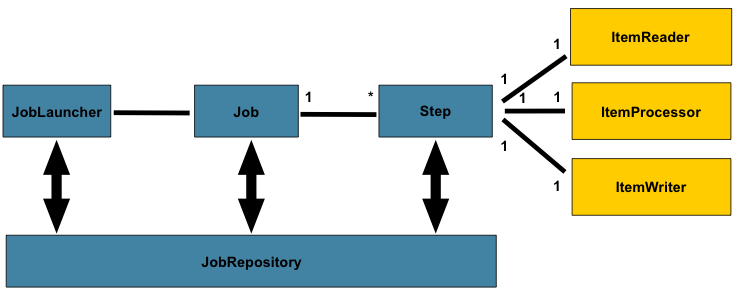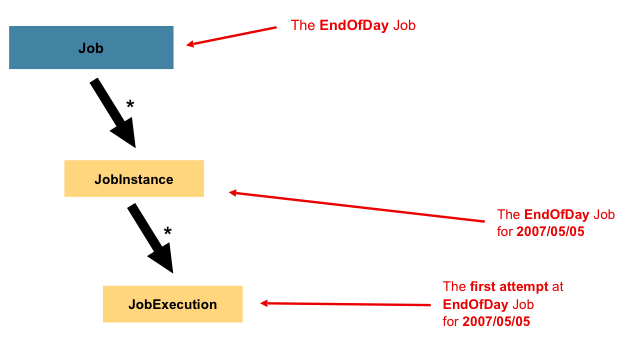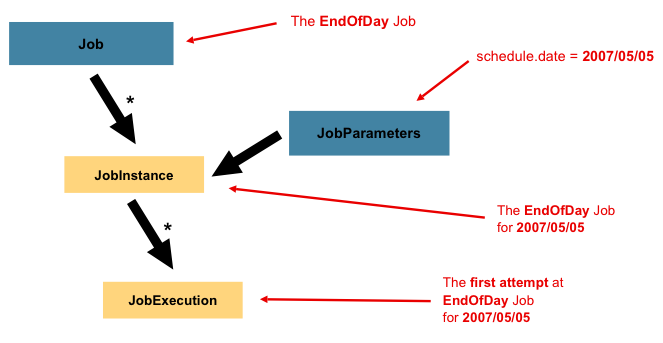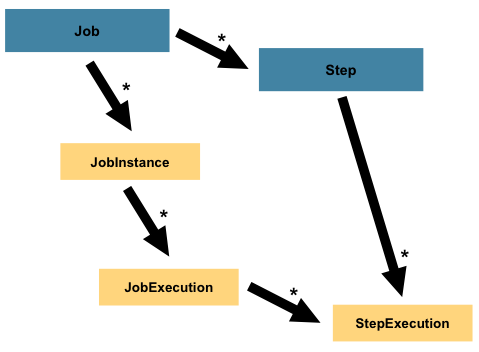The Domain Language of Batch
To any experienced batch architect, the overall concepts of batch processing used in
Spring Batch should be familiar and comfortable. There are "Jobs" and "Steps" and
developer-supplied processing units called ItemReader and ItemWriter. However,
because of the Spring patterns, operations, templates, callbacks, and idioms, there are
opportunities for the following:
-
Significant improvement in adherence to a clear separation of concerns.
-
Clearly delineated architectural layers and services provided as interfaces.
-
Simple and default implementations that allow for quick adoption and ease of use out-of-the-box.
-
Significantly enhanced extensibility.
The following diagram is a simplified version of the batch reference architecture that has been used for decades. It provides an overview of the components that make up the domain language of batch processing. This architecture framework is a blueprint that has been proven through decades of implementations on the last several generations of platforms (COBOL/Mainframe, C/Unix, and now Java/anywhere). JCL and COBOL developers are likely to be as comfortable with the concepts as C, C#, and Java developers. Spring Batch provides a physical implementation of the layers, components, and technical services commonly found in the robust, maintainable systems that are used to address the creation of simple to complex batch applications, with the infrastructure and extensions to address very complex processing needs.

The preceding diagram highlights the key concepts that make up the domain language of
Spring Batch. A Job has one to many steps, each of which has exactly one ItemReader,
one ItemProcessor, and one ItemWriter. A job needs to be launched (with
JobLauncher), and metadata about the currently running process needs to be stored (in
JobRepository).
Job
This section describes stereotypes relating to the concept of a batch job. A Job is an
entity that encapsulates an entire batch process. As is common with other Spring
projects, a Job is wired together with either an XML configuration file or Java-based
configuration. This configuration may be referred to as the "job configuration". However,
Job is just the top of an overall hierarchy, as shown in the following diagram:

In Spring Batch, a Job is simply a container for Step instances. It combines multiple
steps that belong logically together in a flow and allows for configuration of properties
global to all steps, such as restartability. The job configuration contains:
-
The simple name of the job.
-
Definition and ordering of
Stepinstances. -
Whether or not the job is restartable.
For those who use Java configuration, Spring Batch provices a default implementation of
the Job interface in the form of the SimpleJob class, which creates some standard
functionality on top of Job. When using java based configuration, a collection of
builders is made available for the instantiation of a Job, as shown in the following
example:
@Bean
public Job footballJob() {
return this.jobBuilderFactory.get("footballJob")
.start(playerLoad())
.next(gameLoad())
.next(playerSummarization())
.end()
.build();
}For those who use XML configuration, Spring Batch provides a default implementation of the
Job interface in the form of the SimpleJob class, which creates some standard
functionality on top of Job. However, the batch namespace abstracts away the need to
instantiate it directly. Instead, the <job> element can be used, as shown in the
following example:
<job id="footballJob">
<step id="playerload" next="gameLoad"/>
<step id="gameLoad" next="playerSummarization"/>
<step id="playerSummarization"/>
</job>JobInstance
A JobInstance refers to the concept of a logical job run. Consider a batch job that
should be run once at the end of the day, such as the 'EndOfDay' Job from the preceding
diagram. There is one 'EndOfDay' job, but each individual run of the Job must be
tracked separately. In the case of this job, there is one logical JobInstance per day.
For example, there is a January 1st run, a January 2nd run, and so on. If the January 1st
run fails the first time and is run again the next day, it is still the January 1st run.
(Usually, this corresponds with the data it is processing as well, meaning the January
1st run processes data for January 1st). Therefore, each JobInstance can have multiple
executions (JobExecution is discussed in more detail later in this chapter), and only
one JobInstance corresponding to a particular Job and identifying JobParameters can
run at a given time.
The definition of a JobInstance has absolutely no bearing on the data to be loaded.
It is entirely up to the ItemReader implementation to determine how data is loaded. For
example, in the EndOfDay scenario, there may be a column on the data that indicates the
'effective date' or 'schedule date' to which the data belongs. So, the January 1st run
would load only data from the 1st, and the January 2nd run would use only data from the
2nd. Because this determination is likely to be a business decision, it is left up to the
ItemReader to decide. However, using the same JobInstance determines whether or not
the 'state' (that is, the ExecutionContext, which is discussed later in this chapter)
from previous executions is used. Using a new JobInstance means 'start from the
beginning', and using an existing instance generally means 'start from where you left
off'.
JobParameters
Having discussed JobInstance and how it differs from Job, the natural question to ask
is: "How is one JobInstance distinguished from another?" The answer is:
JobParameters. A JobParameters object holds a set of parameters used to start a batch
job. They can be used for identification or even as reference data during the run, as
shown in the following image:

In the preceding example, where there are two instances, one for January 1st, and another
for January 2nd, there is really only one Job, but it has two JobParameter objects:
one that was started with a job parameter of 01-01-2017 and another that was started with
a parameter of 01-02-2017. Thus, the contract can be defined as: JobInstance = Job
+ identifying JobParameters. This allows a developer to effectively control how a
JobInstance is defined, since they control what parameters are passed in.
Not all job parameters are required to contribute to the identification of a
JobInstance. By default, they do so. However, the framework also allows the submission
of a Job with parameters that do not contribute to the identity of a JobInstance.
|
JobExecution
A JobExecution refers to the technical concept of a single attempt to run a Job. An
execution may end in failure or success, but the JobInstance corresponding to a given
execution is not considered to be complete unless the execution completes successfully.
Using the EndOfDay Job described previously as an example, consider a JobInstance for
01-01-2017 that failed the first time it was run. If it is run again with the same
identifying job parameters as the first run (01-01-2017), a new JobExecution is
created. However, there is still only one JobInstance.
A Job defines what a job is and how it is to be executed, and a JobInstance is a
purely organizational object to group executions together, primarily to enable correct
restart semantics. A JobExecution, however, is the primary storage mechanism for what
actually happened during a run and contains many more properties that must be controlled
and persisted, as shown in the following table:
Property |
Definition |
Status |
A |
startTime |
A |
endTime |
A |
exitStatus |
The |
createTime |
A |
lastUpdated |
A |
executionContext |
The "property bag" containing any user data that needs to be persisted between executions. |
failureExceptions |
The list of exceptions encountered during the execution of a |
These properties are important because they are persisted and can be used to completely determine the status of an execution. For example, if the EndOfDay job for 01-01 is executed at 9:00 PM and fails at 9:30, the following entries are made in the batch metadata tables:
JOB_INST_ID |
JOB_NAME |
1 |
EndOfDayJob |
JOB_EXECUTION_ID |
TYPE_CD |
KEY_NAME |
DATE_VAL |
IDENTIFYING |
1 |
DATE |
schedule.Date |
2017-01-01 |
TRUE |
JOB_EXEC_ID |
JOB_INST_ID |
START_TIME |
END_TIME |
STATUS |
1 |
1 |
2017-01-01 21:00 |
2017-01-01 21:30 |
FAILED |
| Column names may have been abbreviated or removed for the sake of clarity and formatting. |
Now that the job has failed, assume that it took the entire night for the problem to be
determined, so that the 'batch window' is now closed. Further assuming that the window
starts at 9:00 PM, the job is kicked off again for 01-01, starting where it left off and
completing successfully at 9:30. Because it is now the next day, the 01-02 job must be
run as well, and it is kicked off just afterwards at 9:31 and completes in its normal one
hour time at 10:30. There is no requirement that one JobInstance be kicked off after
another, unless there is potential for the two jobs to attempt to access the same data,
causing issues with locking at the database level. It is entirely up to the scheduler to
determine when a Job should be run. Since they are separate JobInstances, Spring
Batch makes no attempt to stop them from being run concurrently. (Attempting to run the
same JobInstance while another is already running results in a
JobExecutionAlreadyRunningException being thrown). There should now be an extra entry
in both the JobInstance and JobParameters tables and two extra entries in the
JobExecution table, as shown in the following tables:
JOB_INST_ID |
JOB_NAME |
1 |
EndOfDayJob |
2 |
EndOfDayJob |
JOB_EXECUTION_ID |
TYPE_CD |
KEY_NAME |
DATE_VAL |
IDENTIFYING |
1 |
DATE |
schedule.Date |
2017-01-01 00:00:00 |
TRUE |
2 |
DATE |
schedule.Date |
2017-01-01 00:00:00 |
TRUE |
3 |
DATE |
schedule.Date |
2017-01-02 00:00:00 |
TRUE |
JOB_EXEC_ID |
JOB_INST_ID |
START_TIME |
END_TIME |
STATUS |
1 |
1 |
2017-01-01 21:00 |
2017-01-01 21:30 |
FAILED |
2 |
1 |
2017-01-02 21:00 |
2017-01-02 21:30 |
COMPLETED |
3 |
2 |
2017-01-02 21:31 |
2017-01-02 22:29 |
COMPLETED |
| Column names may have been abbreviated or removed for the sake of clarity and formatting. |
Step
A Step is a domain object that encapsulates an independent, sequential phase of a batch
job. Therefore, every Job is composed entirely of one or more steps. A Step contains
all of the information necessary to define and control the actual batch processing. This
is a necessarily vague description because the contents of any given Step are at the
discretion of the developer writing a Job. A Step can be as simple or complex as the
developer desires. A simple Step might load data from a file into the database,
requiring little or no code (depending upon the implementations used). A more complex
Step may have complicated business rules that are applied as part of the processing. As
with a Job, a Step has an individual StepExecution that correlates with a unique
JobExecution, as shown in the following image:

StepExecution
A StepExecution represents a single attempt to execute a Step. A new StepExecution
is created each time a Step is run, similar to JobExecution. However, if a step fails
to execute because the step before it fails, no execution is persisted for it. A
StepExecution is created only when its Step is actually started.
Step executions are represented by objects of the StepExecution class. Each execution
contains a reference to its corresponding step and JobExecution and transaction related
data, such as commit and rollback counts and start and end times. Additionally, each step
execution contains an ExecutionContext, which contains any data a developer needs to
have persisted across batch runs, such as statistics or state information needed to
restart. The following table lists the properties for StepExecution:
Property |
Definition |
Status |
A |
startTime |
A |
endTime |
A |
exitStatus |
The |
executionContext |
The "property bag" containing any user data that needs to be persisted between executions. |
readCount |
The number of items that have been successfully read. |
writeCount |
The number of items that have been successfully written. |
commitCount |
The number of transactions that have been committed for this execution. |
rollbackCount |
The number of times the business transaction controlled by the |
readSkipCount |
The number of times |
processSkipCount |
The number of times |
filterCount |
The number of items that have been 'filtered' by the |
writeSkipCount |
The number of times |
ExecutionContext
An ExecutionContext represents a collection of key/value pairs that are persisted and
controlled by the framework in order to allow developers a place to store persistent
state that is scoped to a StepExecution object or a JobExecution object. For those
familiar with Quartz, it is very similar to JobDataMap. The best usage example is to
facilitate restart. Using flat file input as an example, while processing individual
lines, the framework periodically persists the ExecutionContext at commit points. Doing
so allows the ItemReader to store its state in case a fatal error occurs during the run
or even if the power goes out. All that is needed is to put the current number of lines
read into the context, as shown in the following example, and the framework will do the
rest:
executionContext.putLong(getKey(LINES_READ_COUNT), reader.getPosition());Using the EndOfDay example from the Job Stereotypes section as an example, assume there
is one step, 'loadData', that loads a file into the database. After the first failed run,
the metadata tables would look like the following example:
JOB_INST_ID |
JOB_NAME |
1 |
EndOfDayJob |
JOB_INST_ID |
TYPE_CD |
KEY_NAME |
DATE_VAL |
1 |
DATE |
schedule.Date |
2017-01-01 |
JOB_EXEC_ID |
JOB_INST_ID |
START_TIME |
END_TIME |
STATUS |
1 |
1 |
2017-01-01 21:00 |
2017-01-01 21:30 |
FAILED |
STEP_EXEC_ID |
JOB_EXEC_ID |
STEP_NAME |
START_TIME |
END_TIME |
STATUS |
1 |
1 |
loadData |
2017-01-01 21:00 |
2017-01-01 21:30 |
FAILED |
STEP_EXEC_ID |
SHORT_CONTEXT |
1 |
{piece.count=40321} |
In the preceding case, the Step ran for 30 minutes and processed 40,321 'pieces', which
would represent lines in a file in this scenario. This value is updated just before each
commit by the framework and can contain multiple rows corresponding to entries within the
ExecutionContext. Being notified before a commit requires one of the various
StepListener implementations (or an ItemStream), which are discussed in more detail
later in this guide. As with the previous example, it is assumed that the Job is
restarted the next day. When it is restarted, the values from the ExecutionContext of
the last run are reconstituted from the database. When the ItemReader is opened, it can
check to see if it has any stored state in the context and initialize itself from there,
as shown in the following example:
if (executionContext.containsKey(getKey(LINES_READ_COUNT))) {
log.debug("Initializing for restart. Restart data is: " + executionContext);
long lineCount = executionContext.getLong(getKey(LINES_READ_COUNT));
LineReader reader = getReader();
Object record = "";
while (reader.getPosition() < lineCount && record != null) {
record = readLine();
}
}In this case, after the above code runs, the current line is 40,322, allowing the Step
to start again from where it left off. The ExecutionContext can also be used for
statistics that need to be persisted about the run itself. For example, if a flat file
contains orders for processing that exist across multiple lines, it may be necessary to
store how many orders have been processed (which is much different from the number of
lines read), so that an email can be sent at the end of the Step with the total number
of orders processed in the body. The framework handles storing this for the developer, in
order to correctly scope it with an individual JobInstance. It can be very difficult to
know whether an existing ExecutionContext should be used or not. For example, using the
'EndOfDay' example from above, when the 01-01 run starts again for the second time, the
framework recognizes that it is the same JobInstance and on an individual Step basis,
pulls the ExecutionContext out of the database, and hands it (as part of the
StepExecution) to the Step itself. Conversely, for the 01-02 run, the framework
recognizes that it is a different instance, so an empty context must be handed to the
Step. There are many of these types of determinations that the framework makes for the
developer, to ensure the state is given to them at the correct time. It is also important
to note that exactly one ExecutionContext exists per StepExecution at any given time.
Clients of the ExecutionContext should be careful, because this creates a shared
keyspace. As a result, care should be taken when putting values in to ensure no data is
overwritten. However, the Step stores absolutely no data in the context, so there is no
way to adversely affect the framework.
It is also important to note that there is at least one ExecutionContext per
JobExecution and one for every StepExecution. For example, consider the following
code snippet:
ExecutionContext ecStep = stepExecution.getExecutionContext();
ExecutionContext ecJob = jobExecution.getExecutionContext();
//ecStep does not equal ecJobAs noted in the comment, ecStep does not equal ecJob. They are two different
ExecutionContexts. The one scoped to the Step is saved at every commit point in the
Step, whereas the one scoped to the Job is saved in between every Step execution.
JobRepository
JobRepository is the persistence mechanism for all of the Stereotypes mentioned above.
It provides CRUD operations for JobLauncher, Job, and Step implementations. When a
Job is first launched, a JobExecution is obtained from the repository, and, during
the course of execution, StepExecution and JobExecution implementations are persisted
by passing them to the repository.
The Spring Batch XML namespace provides support for configuring a JobRepository instance
with the <job-repository> tag, as shown in the following example:
<job-repository id="jobRepository"/>When using Java configuration, the @EnableBatchProcessing annotation provides a
JobRepository as one of the components automatically configured out of the box.
JobLauncher
JobLauncher represents a simple interface for launching a Job with a given set of
JobParameters, as shown in the following example:
public interface JobLauncher {
public JobExecution run(Job job, JobParameters jobParameters)
throws JobExecutionAlreadyRunningException, JobRestartException,
JobInstanceAlreadyCompleteException, JobParametersInvalidException;
}It is expected that implementations obtain a valid JobExecution from the
JobRepository and execute the Job.
Item Reader
ItemReader is an abstraction that represents the retrieval of input for a Step, one
item at a time. When the ItemReader has exhausted the items it can provide, it
indicates this by returning null. More details about the ItemReader interface and its
various implementations can be found in
Readers And Writers.
Item Writer
ItemWriter is an abstraction that represents the output of a Step, one batch or chunk
of items at a time. Generally, an ItemWriter has no knowledge of the input it should
receive next and knows only the item that was passed in its current invocation. More
details about the ItemWriter interface and its various implementations can be found in
Readers And Writers.
Item Processor
ItemProcessor is an abstraction that represents the business processing of an item.
While the ItemReader reads one item, and the ItemWriter writes them, the
ItemProcessor provides an access point to transform or apply other business processing.
If, while processing the item, it is determined that the item is not valid, returning
null indicates that the item should not be written out. More details about the
ItemProcessor interface can be found in
Readers And Writers.
Batch Namespace
Many of the domain concepts listed previously need to be configured in a Spring
ApplicationContext. While there are implementations of the interfaces above that can be
used in a standard bean definition, a namespace has been provided for ease of
configuration, as shown in the following example:
<beans:beans xmlns="http://www.springframework.org/schema/batch"
xmlns:beans="http://www.springframework.org/schema/beans"
xmlns:xsi="http://www.w3.org/2001/XMLSchema-instance"
xsi:schemaLocation="
http://www.springframework.org/schema/beans
https://www.springframework.org/schema/beans/spring-beans.xsd
http://www.springframework.org/schema/batch
https://www.springframework.org/schema/batch/spring-batch.xsd">
<job id="ioSampleJob">
<step id="step1">
<tasklet>
<chunk reader="itemReader" writer="itemWriter" commit-interval="2"/>
</tasklet>
</step>
</job>
</beans:beans>As long as the batch namespace has been declared, any of its elements can be used. More
information on configuring a Job can be found in Configuring and
Running a Job. More information on configuring a Step can be found in
Configuring a Step.